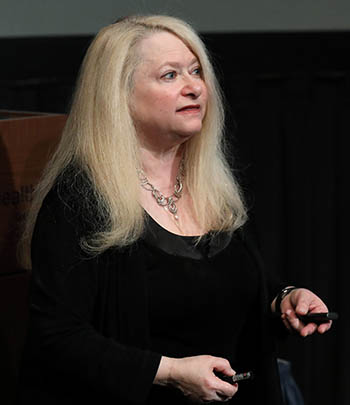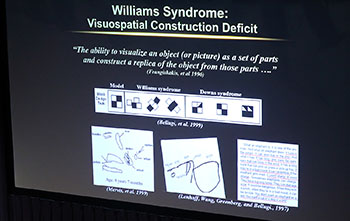Neuroimaging Connects Genetic Mutations to Behavioral Traits
Karen Berman Delivers Anita Roberts Lecture
“You can’t go to medical school; you’re a woman,” someone told Karen Berman in 1969 when she was an undergrad majoring in biology at the University of Rochester (Rochester, New York).
The warning only made Berman more determined to become a doctor and pursue her dream of helping people suffering from neuropsychiatric diseases.

CREDIT: CHIA CHI CHARLIE CHANG
At the Anita Roberts lecture in May, NIMH Senior Investigator Karen Berman talked about her research on Williams syndrome, a developmental disorder caused by deletions of a subset of genes on chromosome 7.
Today, she is a physician, senior investigator, and chief of the Clinical and Translational Neuroscience Branch in the National Institute of Mental Health (NIMH). She pioneered the use of neuroimaging to map brain structure, function, and neurochemical mechanisms associated with schizophrenia, Williams syndrome, and aging. She’s won several awards in recognition of her work and is an elected member of the National Academy of Medicine. And she cares deeply about helping her patients.
Berman described her work on May 30 in Lipsett Amphitheater (Building 10) for the annual Anita B. Roberts lecture, which honors distinguished women scientists and mentors. Berman exudes a calm and steady confidence when she steps up to the podium to speak or invites you into her office. She is warm and friendly but leaves no doubt about her intelligence and drive when it comes to her work.
Berman’s primary interest has always been schizophrenia, but much of her work has centered on Williams syndrome, a developmental disorder caused by deletions of a subset of genes on chromosome 7. Because the genetic mutations and their dramatic effects are known, Williams syndrome is an excellent model for studying the associations among genetic factors, brain structure and function, and behavioral characteristics. These studies are Berman’s bread and butter and have driven her career forward for nearly 40 years.
Williams syndrome is characterized by a pattern of cognitive strengths and weaknesses. People with the syndrome excel in verbal abilities and facial expression recognition, but their visuospatial construction abilities (writing, drawing, and pattern construction) are weak. For example, when trying to draw a bicycle, children with Williams syndrome draw odd, disjointed shapes that are barely recognizable when compared with drawings of other children their age. People with Williams syndrome tend to be very social, friendly, and endearing, and children with the syndrome lack normal shyness around strangers. On the other hand, they have medical problems such as cardiac disease and an increase in phobias and anxieties related to non-social situations.

CREDIT: CHIA CHI CHARLIE CHANG
Because the genetic mutations and their dramatic effects are known, Williams syndrome is an excellent model for studying the associations among genetic factors, brain structure and function, and behavioral characteristics. The syndrome is characterized by a pattern of cognitive strengths and weaknesses. People with the syndrome excel in verbal abilities and facial expression recognition, but their visuospatial construction abilities (writing, drawing, and pattern construction) are weak.
Berman’s use of functional neuroimaging of the brain has enabled her to trace the patterns of brain structure and activity in these patients as they perform complex cognitive activities. From the visual cortex of the brain, there are two primary streams, or pathways, of information processing—ventral and dorsal. The brains of Williams syndrome patients have a loss of gray-matter volume in the dorsal stream and show reduced activity in that area when asked to perform certain tasks, such as drawing a bicycle. Through combining the neuroimaging studies with studies of genetic deletions and single nucleotide polymorphisms (SNPs), Berman and her colleagues have illuminated the specific genes and SNPs that, at least in part, drive the behavioral symptoms.
In 96% of the patients, the syndrome is caused by the same hemi-deletion (when only one of two paired chromosomes is deleted) of 26 to 28 genes on chromosome 7. In all of these cases, two particular genes are always deleted, the gene that codes for elastin (ELN) and the gene for serine-threonine kinase (LIMK1). Hemi-deletion of LIMK1 by itself is enough to cause the visuospatial problems of Williams syndrome. Even in the general population, certain SNPs in LIMK1 affect the volume of gray matter and activity in the dorsal visual-processing stream.
Additional SNP studies in the same chromosomal region revealed another important gene—the gene for general transcription factor IIi (GTF2I). Deletion of GTF2I is also involved in the hypersociability of people with Williams syndrome. Berman hopes that being able to connect these genetic mutations to brain structure and function and behavioral traits will help scientists identify pathways for other neuropsychiatric diseases and disorders.
When asked where the work goes from here, Berman’s answer is that it’s all about the patients. It’s about developing therapies and improving the patients’ lives, she said. Although she hopes that her study techniques can be applied to more complex diseases such as schizophrenia, she acknowledges the additional complications of that condition. Unlike Williams syndrome, schizophrenia has many known associated genes, each with relatively small effects, making it incredibly difficult to pinpoint any one cause or target for treatment. Actual treatments may be a while off, but the work Berman and her colleagues are doing is providing a strong knowledge base and set of techniques that will continue to be applied.
Inside and outside of the lab, Berman is eager to share her knowledge with new and future trainees. She serves as a leader, a role model, and an example of a woman pushing the boundaries of science. Although she believes that there is still progress to be made in the representation of women in research, she acknowledges that things are much improved since the 1970s.
After receiving her M.D. from the St. Louis University School of Medicine (St. Louis, Missouri), she completed residencies in psychiatry—at the Washington University School of Medicine in St. Louis (St. Louis, Missouri), University of California San Diego School of Medicine (La Jolla, California), and NIH—and a fellowship in nuclear medicine at NIH. She is board certified in both psychiatry and nuclear medicine. She’s gone on to have a successful career, is happily married to an accomplished NIH scientist and has raised two wonderful sons.
Her secret? Dedication and mental toughness, she said. “You can have it all.”
The “Anita B. Roberts Lecture Series: Distinguished Women Scientists at NIH” honors the research contributions Roberts and other female scientists have made. Roberts, who spent 30 years at NCI before her death in 2006, was known for her groundbreaking work on transforming growth factor–beta.
This page was last updated on Thursday, March 31, 2022
